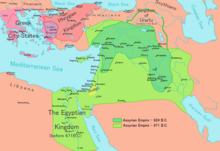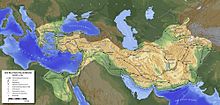Middle East
Coordinates: 25 ° 50 ′ 22 ″ N , 43 ° 14 ′ 31 ″ E Western Asia (also West Asia or South West Asia ) is a collective term for a region in the southwest of the continent Asia . The three terms are interchangeable, with the Middle East includinga European perspective. There are different ideas about the exact delimitation.
Demarcation
According to the definition prevailing today, the Middle East is bounded in the west by the Mediterranean Sea and the Red Sea , in the north by the Black Sea , the Caucasus and the Caspian Sea , in the east by the outskirts of Iran and in the south by the Indian Ocean .
The Middle East is connected to Africa via the Sinai peninsula , while the Dardanelles , the Sea of Marmara and the Bosporus form only a narrow separation from Europe .
The Middle East includes Asia Minor , Caucasus , Mesopotamia , Syria , Palestine , the Arab and Sinai Peninsula , the Armenian Highlands and the Iranian Highlands .
Afghanistan is in the transition area to Central Asia . Iran , which always belongs to the Middle East, is not assigned to the Middle East but to South Asia in the division of the UN Department UNSD , exclusively for statistical purposes and this designation adopts and does not imply any relationship or connection between the countries concerned.
Related terms
There is extensive overlap with the term Middle East , which designates the Arab states of the Middle East and Israel and also includes Cyprus , Iran , Turkey (sometimes only Anatolia ) and Egypt .
Other terms used for the region are Orient and Middle East .
List of states
The following states and dependent areas are geographically included in the Middle East:
-
 Egypt ( Sinai Peninsula only )
Egypt ( Sinai Peninsula only ) -
 Armenia
Armenia
-
 Azerbaijan
Azerbaijan
-
 Bahrain
Bahrain
-
 Georgia
Georgia
-
 Iraq
Iraq
-
 Iran
Iran
-
 Israel
Israel
-
 Yemen (excluding Socotra Island )
Yemen (excluding Socotra Island ) -
 Jordan
Jordan
-
 Qatar
Qatar
-
 Kuwait
Kuwait
-
 Lebanon
Lebanon
-
 Oman
Oman
-
 Palestine
Palestine
-
 Saudi Arabia
Saudi Arabia
-
 Syria
Syria
-
 Turkey (Asian part, i.e. Anatolia )
Turkey (Asian part, i.e. Anatolia ) -
 United Arab Emirates
United Arab Emirates
-
 Cyprus (politically part of the EU )
Cyprus (politically part of the EU )
history
Some key points in the history of the Near East:
- Around 900 BC With the New Assyrian Empire, the first world empire came into being.
- The Persian Empire followed, with the greatest expansion under King Dareios I in the 5th century BC. Chr.
- Alexander the Great conquered the Persian Empire and established by 323 BC A large empire of its own, which fell to its generals, the Diadochi , after his death .
- Under the Parthian King Mithridates II , 115 BC. The Silk Road "opened", one of the most important trade routes from the Mediterranean through the Middle East via Central Asia to East Asia .
- 70 BC The Roman Empire reached the region and expanded to 300 AD.
- In late antiquity , from the 3rd to the 7th centuries, East / Byzantium and the neo -Persian Sassanid Empire were at war in the Roman-Persian wars .
- In the 7th century the Arabs conquered large parts of the Middle East.
- From the 13th century, the Ottomans conquered Anatolia from the Byzantine Empire and in 1453 Constantinople . The Ottomans reached the height of their power in the 16th and 17th centuries.
literature
- Charles Burney, David Marshall Lang : The hill tribes of the Middle East. Armenia and the Caucasus from prehistoric times to the Mongol storm. Zurich 1973, ISBN 3-463-13690-2 .
- Bedřich Hrozný : The oldest history of the Middle East and India. 2nd Edition. Melantrich, Prague 1943, ISBN 3-7648-2635-5 .
Individual evidence
- ^ Standard Country or Area Codes for Statistical Use . Millenniumindicators.un.org. Retrieved August 25, 2012. Quote: "The assignment of countries or areas to specific groupings is for statistical convenience and does not imply any assumption regarding political or other affiliation of countries or territories by the United Nations."
- ↑ Middle East , Bibliographisches Institut & FA Brockhaus AG, 2000.
- ^ The World Factbook, United States Central Intelligence Agency (CIA), November 14, 2006; [1] The Million Person Gap: The Arab Population in the West Bank and Gaza; B. Zimmerman, R. Seid and ML Wise; The Begin-Sadat Center for Strategic Studies, Bar-Ilan University; February, 2006 The Million Person Gap: The Arab Population in the West Bank and Gaza (PDF file; 2.13 MB) Sergio Della Pergola, "Letter to the editor", Azure, 2007, no. 27, [2] Sergio DellaPergola criticizes the authors of the study on the “Palestinian Census 2007” for serious statistical and methodological deficiencies.



